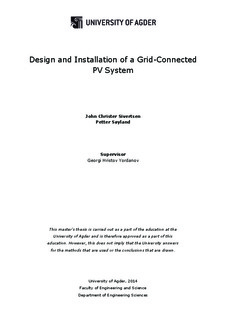| dc.description.abstract | As the worlds electrical demand is being more covered by photovoltaic (PV) systems, Germanyinstalled 3.3 GW of the worlds PV systems in 2013 compared to 0.6 MW being installed inNorway. Irradiation measurements done for southern Norway indicates that the conditions formore PV systems being installed are good when comparing irradiation in Grimstad to Hamburg.This thesis addresses the initial steps of planning and building a PV system to analysing howthe inverter handles the varying irradiance in southern Norway.To investigate the opportunities in Grimstad, a Theia HE-t 3.8 string inverter from Eltek wasinstalled along with 23 de-rated PV modules to constitute a PV system of 2.116 kWp. The PVsystem was estimated to have a system loss of 20.4 % and a yearly production of 2088 kWh withan average performance ratio of 80 %, which is considered to be good for a small PV systemwith aged PV modules. From when the system started commissioning to when this thesis wasfinalized, approximately one month of measurements was recorded, providing information onhow the inverter operated on clear and cloudy days as well as days with overirradiance.Results indicate that the inverter efficiency drops during early and late operating hours onsunny days, as well as during midday on cloudy days. This was found to be a result of theinverter using two di↵erent algorithms for low and high irradiance. When the inverter switchesalgorithms, it could operate at a not optimal efficiency for 10 minutes up to two hours dependentof the available irradiance, the inverter will then operate at a high efficiency for as long as itis operating with one specific algorithm. One day with overirradiance reviled that the inverterresponds rapidly to sudden irradiance changes and were able to produce 2.8 kWAC at irradianceclose to 1.5 suns. It therefore has good preconditions for handling varying irradiance whileoperating at an average high efficiency. For the one month of operation the inverter managedto produce 313 kWh, which is more than was estimated for May. With a lack of more monthsto compare with and from the results recorded for May, the PV system has good prospects forfuture operation and to produce the expected 2088 kWh/year or more. | nb_NO |
